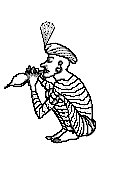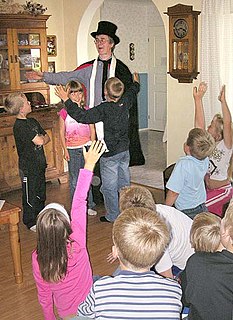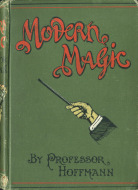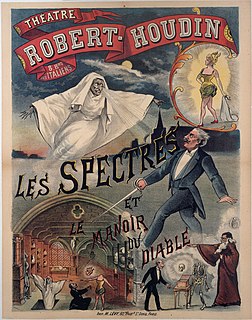
Harry Houdini was a Hungarian-American escape artist, illusionist, stunt performer and mysteriarch, noted for his escape acts.

Escapology is the practice of escaping from restraints or other traps. Escapologists escape from handcuffs, straitjackets, cages, coffins, steel boxes, barrels, bags, burning buildings, fish-tanks, and other perils, often in combination.

The cups and balls is a performance of magic with innumerable adaptations. Street gambling variations performed by conmen were known as Bunco Booths. A typical cups and balls routine includes many of the most fundamental effects of magic: the balls can vanish, appear, transpose, reappear and transform. Basic skills, such as misdirection, manual dexterity, sleight of hand, and audience management are also essential to most cups and balls routines. As a result, mastery of the cups and balls is considered by many as the litmus test of a magician's skill with gimmick style tricks. Magician John Mulholland wrote that Harry Houdini had expressed the opinion that no one could be considered an accomplished magician until he had mastered the cups and balls. Professor Hoffman called the cups and balls "the groundwork of all legerdemain".

P. T. Selbit (1881–1938) was an English magician, inventor and writer who is credited with being the first person to perform the illusion of sawing a woman in half. Among magicians he was known for his inventiveness and entrepreneurial instinct and he is credited with creating a long list of successful stage illusions.
A trick deck usually refers to a deck of playing cards that has been altered in some way to allow magicians to perform certain card tricks where sleight of hand would be too difficult or impractical.
Walter Brown Gibson was an American author and professional magician, best known for his work on the pulp fiction character The Shadow. Gibson, under the pen-name Maxwell Grant, wrote "more than 300 novel-length" Shadow stories, writing up to "10,000 words a day" to satisfy public demand during the character's golden age in the 1930s and 1940s. He authored several novels in the Biff Brewster juvenile series of the 1960s. He was married to Litzka R. Gibson, also a writer, and the couple lived in New York state.

Dai Vernon, a.k.a. The Professor, was a Canadian magician. His sleight of hand technique and knowledge, particularly with card tricks and close-up magic, garnered him respect among fellow magicians, and he was a mentor to other magicians. He lived out his last years at Magic Castle, a nightclub in Hollywood, California.

Christopher Nicholas Sarantakos, known professionally as Criss Angel, is an American magician, illusionist and musician. Angel began his career in New York City, before moving his base of operations to the Las Vegas Valley. He is known for starring in the television and stage show Criss Angel Mindfreak and his previous live performance illusion show Criss Angel Believe in collaboration with Cirque du Soleil at the Luxor casino in Las Vegas. The show generated $150 million in tourist revenue to Las Vegas in 2010, but has since been replaced by Mindfreak LIVE! in 2016. He also starred in the television series Criss Angel BeLIEve on Spike TV, the reality-competition television show Phenomenon on NBC, and the 2014 stage show Criss Angel Magicjam.
This timeline of magic is a history of the performing art from B.C. to the present.

The Society of American Magicians (S.A.M.) is the oldest fraternal magic organization in the world. Its purpose is "to advance, elevate, and preserve magic as a performing art, to promote harmonious fellowship throughout the world of magic, and to maintain and improve ethical standards in the field of magic." To promote these endeavors the S.A.M. presents awards and fellowships in recognition of outstanding achievement in the Art of Magic.
Billy McComb was a British-born American magician and comedian. He was one of the United Kingdom's leading magicians in the 1950s and 1960s. He was hired to perform at the International of Magicians in 1962 and stayed at Jim Swoger's house in Pittsburgh, along with his wife and son, for six months before taking up residence in Los Angeles, California in the 1970s. He joined The Magic Castle in Hollywood, his number being 3323.

Dorothy Dietrich is an American stage magician and escapologist, best known for performing the bullet catch in her mouth and the first woman to perform a straitjacket escape while suspended hundreds of feet in the air from a burning rope. She was the first woman to gain prominence as an escape artist since the days of Houdini, breaking the glass ceiling for women in the field of escapes and magic.

Stage or street magic has a long history in India. Popular tricks include the rope trick, Indian basket, and Indian cups and ball.

The Tarbell Course in Magic is a notable encyclopedia of magic amongst professional and amateur magicians. It has eight volumes; the first five were part of the original home-study correspondence course compiled in 1928 by Dr. Harlan Tarbell, the remaining three volumes being added on later.

Children's magic is a specialized aspect of parlor magic and is meant to entertain children. It is typically performed at birthday parties, churches, preschools, elementary schools, Sunday Schools or libraries. It is often the only type of magic most Westerners experience other than that seen on television. This type of magic is usually comedic in nature.

Chink-a-chink is a simple close-up magic coin trick in which a variety of small objects, usually four, appear to magically transport themselves from location to location when covered by the performer's hands, until the items end up gathered together in the same place. Variations, especially the Sympathetic Coins also known as Coins-n-Cards, have been performed since the 1800s. Popular modern variations are Shadow Coins and Matrix. A variation using playing cards as the objects is known as Sympathetic Aces.

William Ellis Stanyon was a professional magician and magic dealer in London.

Magic, which encompasses the subgenres of illusion, stage magic, and close up magic, among others, is a performing art in which audiences are entertained by tricks, effects, or illusions of seemingly impossible feats, using natural means. It is to be distinguished from paranormal magic which are effects claimed to be created through supernatural means. It is one of the oldest performing arts in the world.

Modern Magic by Professor Hoffmann is a treatise in book form, first published in 1876, detailing the apparatus, methods and tricks used by the magicians and conjurors of that era. Hoffmann was considered to be one of the greatest authorities on the theory and practice of magic, despite his own limited professional experience as a magician.

The Théâtre Robert-Houdin, initially advertised as the Théâtre des Soirées Fantastiques de Robert-Houdin, was a Paris theatre dedicated primarily to the performance of stage illusions. Founded by the famous magician Jean-Eugène Robert-Houdin in 1845 at No. 164 Galerie Valois as part of the Palais-Royal, it moved in 1852 to a permanent home at No. 8, Boulevard des Italiens. The theatre's later directors, before its demolition in 1924, included Robert-Houdin's protégé Hamilton and the illusionist and film innovator Georges Méliès.















